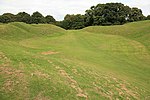Cirencester College
1991 establishments in EnglandCirencesterEducational institutions established in 1991Further education colleges in GloucestershireLearning and Skills Beacons ... and 2 more
United Kingdom university stubsUse British English from September 2013

Cirencester College is a sixth form college based in the town of Cirencester in the South Cotswolds. It is a specialist sixth form provider serving communities in Gloucestershire, South Gloucestershire, Wiltshire and Oxfordshire. Cirencester College offers a wide choice of qualifications including A-levels, the new T-levels In addition to vocational training, the college has a good track-record of sending students on to higher education at a range of universities, apprenticeships and straight into employment.
Excerpt from the Wikipedia article Cirencester College (License: CC BY-SA 3.0, Authors, Images).Cirencester College
Stroud Road, Cotswold District
Geographical coordinates (GPS) Address Phone number Website External links Nearby Places Show on map
Geographical coordinates (GPS)
| Latitude | Longitude |
|---|---|
| N 51.7125 ° | E -1.9861111111111 ° |
Address
Cirencester College
Stroud Road
GL7 1XA Cotswold District
England, United Kingdom
Open on Google Maps








